|
This Site:
Civil War
Civil War Overview
Civil War 1861
Civil War 1862
Civil War 1863
Civil War 1864
Civil War 1865
Civil War Battles
Confederate Generals
Union Generals
Confederate History
Robert E. Lee
Civil War Medicine
Lincoln Assassination
Slavery
Site Search
Civil War Links
Civil War Art
Revolutionary War
Mexican War
Republic of Texas
Indians
Winslow Homer
Thomas Nast
Mathew Brady
Western Art
Civil War Gifts
Robert E. Lee Portrait
|
|
Sherman's March to the Sea.
General Grant arranged two campaigns for the year 1864. One, under
his own immediate direction, was for the seizure of
Richmond, the
Confederate capital; the other was for the
seizure of Atlanta, Ga., the focus of several converging railways. The
latter expedition was led by
General Sherman. His army numbered nearly
100,000 men, comprising the Army of the Cumberland, led by
Gen. George H.
Thomas; the Army of the Tennessee, commanded by
Gen. J. R. McPherson: and
the Army of the Ohio, led by Gen. J. M. Schofield. |
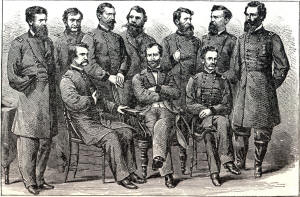
SHERMAN AND HIS GENERALS
|
|
When, on May 6, 1864, Sherman began to move southward
from the vicinity of Chattanooga, his army was confronted by a Confederate
force of 55,000 men, led by confederate
General Joseph E. Johnston, and arranged in three corps, commanded
respectively by Generals Hardee, John Hood,
and Polk. This army then lay at Dalton, at the parting of the ways —one
leading into east Tennessee and the other into west Tennessee. |
|
To strike that position in front was, at least, perilous;
so Sherman began a series of successful flanking movements. When he flanked
the Confederates at Dalton, they fell back to Resaca Station, on the
Oostenaula River, on the line of the railway between Chattanooga and
Atlanta. There a sharp battle was fought
on May 15. Joseph Johnston took his next
position at Allatoona Pass, and Sherman massed his troops at Dallas,
westward of that post, where a severe battle was fought May 25. Johnston finally pressed on to Marietta
and Atlanta, where, towards the middle of July, he was succeeded by
Hood. |
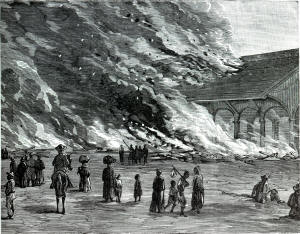
SHERMAN'S
TROOPS BURNING A RAILROAD STATION.
|
|
Atlanta was captured
by Sherman, who entered it Sept. 2, 1864. Late in October Sherman prepared
for a march through Georgia from Atlanta to
Savannah. See
Burning of ATLANTA.
When he resolved to march through the heart of Georgia
from Atlanta to the sea, he delegated to
General Thomas full power over all the troops under his (Sherman's) command
excepting four corps. He also gave him command of two divisions of A. J.
Smith's, then re-turning from the expulsion of Price from Missouri, also of
the garrisons in Tennessee, and all the cavalry of the military division
excepting a division under Kilpatrick, which he reserved for operations in
Georgia. General Wilson had just arrived from
Petersburg to take command of
the cavalry of the army. He was sent to
Nashville to gather up all the Union
cavalry in Kentucky and Tennessee, and report to Thomas. It was believed
that Thomas now had strength sufficient to keep General
John Bell Hood out of Tennessee, whose
force then was about 35,000 infantry and 10,000 cavalry. When, on Nov. 1,
Hood was laying a pontoon bridge over the
Tennessee at Florence for the invasion of Tennessee, Sherman, who had
pursued him, turned his forces towards Atlanta, his troops destroying all
the mills and foundries at Rome, and dismantling the railway from the Etowah
River to the Chattahoochee. The railways around Atlanta were destroyed, and
on Nov. 14 the forces destined for the great march were concentrated around
the doomed city.
Those forces were composed of four army corps, the right
wing commanded by Gen. O. O. Howard, and the left wing by Gen. H. W. Slocum.
Howard's right was composed of the corps of Generals Osterhaus and Blair,
and the left of the corps of Gen. J. C. Davis and A. S. Williams. General
Kilpatrick commanded the cavalry, consisting of one division. |
|
Sherman's entire force numbered 60,000 infantry and
artillery and 5,500 cavalry. On Nov. 11 Sherman cut the telegraph wires that
connected Atlanta with Washington, and his army became an isolated column in
the heart of an enemy's country. It began its march for the sea on the
morning of the 14th, when the entire city of
Atlanta—excepting its courthouse, churches, and dwellings—was committed
to the flames. |
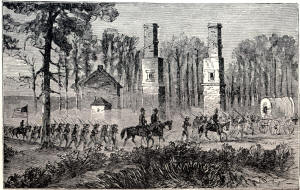
GENERAL SHERMAN
MOVING OUT OF ATLANTA.
|
|
The buildings in the heart of the city, covering 200
acres of ground, formed a great conflagration; and, while the fire was
raging, the bands played, and the soldiers chanted the stirring air and
words, " John Brown's soul goes marching on!"
For thirty-six days that army moved through Georgia, with
very little opposition, pillaging the countryside. It was a sort of military
promenade, requiring very little military skill in the performance, and as
little personal prowess, as well trained union troops were deployed against
defenseless citizens. It was grand in conception, and easily executed. Yet
on that march there were many deeds that tested the prowess and daring of
the soldiers on both sides. Kilpatrick's first dash across the Flint River
and against General Joseph Wheeler's cavalry, and then towards Macon, burning a train of
cars and tearing up the railway, gave the Confederates a suspicion of
Sherman's intentions. There was widespread consternation in Georgia and
South Carolina, for the invader's destination was uncertain. |
|
Confederate
General P. G. T. Beauregard was sent from the Appomattox to the Savannah
to confront the Nationals. He sent before him a manifesto in which he said,
"Destroy all the roads in Sherman's front, flank, and rear," and, "be
trustful in Providence." Benjamin H. Hill, of Georgia., in the Confederate
Congress at Richmond wrote to the people of his State: " Every citizen with
his gun and every negro with his spade and axe can do the work of a soldier.
You can destroy the enemy by retarding his march. Be firm!" The
representatives of Georgia in the Confederate Congress called upon their
people to fly to arms. |
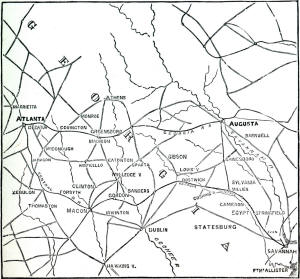
MAP SHOWING SHERMAN'S MARCH TO SEA
|
|
"Remove your negroes, horses, cattle, and provisions from
Sherman's army," they said, " and burn what you cannot carry away. Burn all
bridges and block up the roads in his route. Assail the invader in front.
flank, and rear, by night and by day. Let him have no rest." And Governor
Brown, before he fled from Milledgeville on the approach of the Nationals,
issued a proclamation ordering a levy en masse of the whole white population
of the State between the ages of sixteen and forty-five, and offering pardon
to prisoners in the penitentiary if they would volunteer and prove
themselves good soldiers. But the people did none of these things, and only
about 100 convicts accepted the offer.
All confidence in
President Davis and the
Confederate government had disappeared
in Georgia, and a great portion of the people were satisfied that it was, as
they expressed it, " the rich man's war, and the poor man's fight," and
would no longer lend themselves to the authorities at Richmond. The National
army moved steadily forward. At Griswoldsville there was a sharp engagement
(Nov. 22, 1864) with a portion of Hardee's troops sent up from Savannah, and
several brigades of militia. The Confederates were repulsed with a loss of
2,500 men. Howard could have taken Macon after this blow upon its defenders,
but such was not a part of Sherman's plan. The Nationals were attacked at
the Oconee River while laying a pontoon bridge, but the assailants, largely
composed of Wheeler's cavalry, were defeated. |
|
Kilpatrick made a feint towards Augusta to mislead the
Confederates as to Sherman's destination, also to cover the passage of the
army over the Ogeechee River, and, if possible, to release Union captives in
the prison pen at Millen. Kilpatrick and
Wheeler had several skirmishes, but
no severe battles. On Nov. 30, Sherman's whole army, excepting one corps,
had passed the Ogeechee. This was a most skilful maneuver; and then, having
destroyed the principal railways in Georgia over long distances, Sherman was
prepared to make a final conquest of the State. |
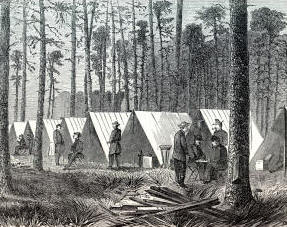
GENERAL SHERMAN'S HEADQUARTERS DURING MARCH
TO THE SEA. |
|
Moving on seaward, the division of Hazen had a severe
skirmish (Dec. 4, 1864) at Statesburg, south of the Ogeechee. The
Confederates were dispersed. On the same day Kilpatrick fought
Wheeler on
the railway between Millen and Augusta, drove him from his barricades
through Waynesboro, and pushed him 8 miles, while a supporting column of
Union infantry under Baird were tearing up the railway and destroying
bridges.
When Sherman reached Millen, the Union prisoners had been
removed; and he pushed on, amid swamps and sands, with the city of
Savannah,
where Hardee was in command, as his chief object. Kilpatrick and Baird
covered the rear of the wing columns between the Ogeechee and
Savannah
rivers. There was some skirmishing, but no Confederates in force were seen
until within 15 miles of Savannah. All the roads leading into that city were
obstructed by felled trees, earthworks, and artillery. These were turned,
and by Dec. 10, 1864 the Confederates were all driven within their lines,
and Savannah was completely beleaguered; but the only approaches to it were
by five narrow causeways. They had broken communications, so that no
supplies could be received in Savannah. Sherman sought to make the Ogeechee
an avenue of supply, oceanward, for his army, and to communicate with the
Union fleet outside. The latter was soon effected. Fort McAllister, near the
mouth of the Ogeechee, was in the way, and, on the 13th, Slocum ordered
General Hazen to carry it by assault. It was a strong, enclosed redoubt,
garrisoned by 200 men. It was carried, and this was the brilliant ending of
the march from Atlanta to the sea. |
|
It opened to Sherman's army a new base of supplies.
Sherman communicated with the officers of the fleet, and, on Dec. 17, he
summoned Hardee to surrender.
Hardee refused. Perceiving the arrangements
made to cut off his retreat to Charleston, Hardee secretly withdrew on the
dark and stormy night of Dec. 20, 1864, and, with 15,000 men, escaped to
that city. The National army took possession of Savannah on Dec. 22. 1864. |
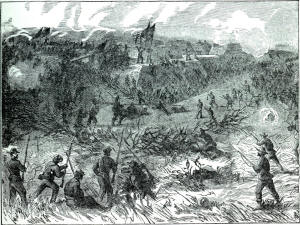
ATTACK ON FORT McALLISTER.
|
|
On the 26th Sherman wrote to
President Lincoln: " I beg
to present to you, as a Christmas gift, the city of Savannah, with 150 heavy
guns and plenty of ammunition, and also about 25,000 bales of cotton." On
his march Sherman had lived generously off the country, helping himself to
the private property of Southern familes. He appropriated to the use of the
army 13,000 beeves, 160,000 bushels of corn, more than 5,000 tons of fodder,
besides a large number of sheep, swine, fowls, and quantities of potatoes
and rice. He forced into the service 5,000 horses and 4,000 mules. He
captured 1,328 prisoners and 167 guns, and destroyed 20,000 bales of cotton.
Fully 10,000 negroes followed the flag to Savannah, and many thousands more,
chiefly women and children, were turned back at the crossings of rivers.
Sherman appointed Jan. 15, 1865, as the day for beginning
his march northward from Savannah. The 17th Corps was sent by water to a
point on the
Charleston and Savannah Railway, where it seriously menaced
Charleston. The left wing, under Slocum, accompanied by Kilpatrick's
cavalry, was to have crossed the Savannah on a pontoon bridge at that city;
but incessant rains had so flooded the swamps and raised the streams that
the army was compelled to cross higher up, and did not effect the passage
until the first week in February. Savannah and its dependencies were
transferred to General Foster, then in command of the Department of the
South, with instructions to cooperate with Sherman's inland movements by
occupying, in succession,
Charleston and other places. Sherman notified
General Grant that it was his intention, after leaving Savannah, "to
undertake, at one stride, to make Goldsboro an open communication with the
sea by the Newbern Railway. Feints of attacks on Charleston kept
Hardee from
interfering with Sherman's inland march. |
|
Wheeler had been putting obstructions in his pathway to
Columbia; but the movements of the Nationals were so mysterious that it
distracted the Confederates, who could not determine whether Sherman's
objective was
Charleston or Augusta. His invasion produced widespread alarm.
Sherman's army steadily advanced in the face of every obstacle. They drove
the Confederates from their position at Orangeburg and began destroying the
railway there. |
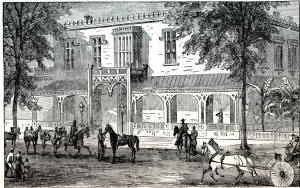
HEADQUARTERS OF GENERAL SHERMAN IN SAVANNAH.
|
|
On Feb. 18 they began a march directly to
Columbia, the
capital of South Carolina, driving the Confederates before them wherever
they appeared. Sherman's march was so rapid that troops for the defense of
the capital could not be gathered in time. He was in front of Columbia
before any adequate force for its defence appeared.
Beauregard was in command there,
and had promised much, but did little. On Feb. 17 the
Nationals entered
Columbia; and on the same day
Charleston, flanked, was evacuated by Hardee.
The rear guard of the Confederates, under Wade Hampton, on retiring, set
fire to cotton in the streets; and the high wind sent the burning fiber into
the air, setting fire to the dwellings, and in the course of a few hours
that beautiful city was in ruins. Sherman, after destroying the arsenal at
Columbia, left the ruined city and pressed on with his forces to
Fayetteville, N. C., his cavalry, under Kilpatrick, fighting the Confederate
cavalry led by Wheeler many times on the way. He left a black path of
desolation through the Carolinas 40 miles in width. Arriving at
Fayetteville, Sherman opened communications with the National troops at
Wilmington.
General Sherman was promoted major general, United States
army, in August, 1864, and lieutenant - general in July, 1866. On March 4,
1869, he succeeded
General Grant as general-in-chief of the armies of the
United States. He was retired on his own request, Feb. 8, 1884, on full pay.
He died in New York City, Feb. 14. 1891.
|
|






